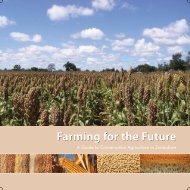Restoring the Soil - Canadian Foodgrains Bank
Restoring the Soil - Canadian Foodgrains Bank
Restoring the Soil - Canadian Foodgrains Bank
You also want an ePaper? Increase the reach of your titles
YUMPU automatically turns print PDFs into web optimized ePapers that Google loves.
Decision Tree Guide41Native trees and exotic trees can both be used to provide dispersed shade. A combinationwill provide a wider variety of trees and increase biodiversity, and will<strong>the</strong>refore be a more sustainable option. If <strong>the</strong> farmers select native tree species, goto #25.25. Dispersed shade with native species. The species you decide to use will probablydepend on what is locally available. If a lot of trees already exist in <strong>the</strong> fields,you can pick and choose among those species, selecting leguminous trees withoutspines, if possible. Though it does have <strong>the</strong> problem of thorns, Faidherbia albida(previously Acacia albida) is easily <strong>the</strong> most desirable in very drought proneareas like <strong>the</strong> nor<strong>the</strong>rn Sahel because it drops its leaves during <strong>the</strong> rainy seasonand <strong>the</strong>refore does not need to be pruned. (O<strong>the</strong>r trees will need some pruningimmediately before <strong>the</strong> rainy season to reduce crop shading.) Fur<strong>the</strong>rmore,because it is dormant during <strong>the</strong> rainy season, it does not compete with nearbycrops for water. Therefore, despite its thorns, F. albida is preferred by farmers innor<strong>the</strong>rn Sahel. Never<strong>the</strong>less, as one moves from <strong>the</strong> drier areas to higher rainfallregions, <strong>the</strong> advantages of <strong>the</strong> F. albida will diminish in importance, and <strong>the</strong>problems of its thorns and relatively slow growth will make it less desirable thansome o<strong>the</strong>r species.Trees like <strong>the</strong> shea butter trees that produce an income are also a desirable option.Those wanting to use native species in dispersed shade systems in very dry areas(such as <strong>the</strong> nor<strong>the</strong>rn Sahel) should consider using <strong>the</strong> Farmer Managed NaturalRegeneration (FMNR) system. In this system, instead of establishing nurseriesand planting trees (a process that in <strong>the</strong>se extremely difficult environments failsmore often than it succeeds), farmers are encouraged to quit cutting or burning,and to protect <strong>the</strong> trees that grow naturally each year from stumps or undergroundroots in <strong>the</strong>ir fields. In many of <strong>the</strong>se environments, well over 50 suchstumps or roots per ha already exist. Trees grown this way almost always survive,and often grow much faster than trees grown from seeds because <strong>the</strong> new trees donot have to grow a new root system. On <strong>the</strong> o<strong>the</strong>r hand, farmers have to resign<strong>the</strong>mselves to having trees of various species growing in <strong>the</strong>ir fields in a randomspacing. In Mali, many Dogon farmers prune <strong>the</strong>se trees in order to maximizecrop production under <strong>the</strong> trees, and some plant additional trees by feedingviable seeds of desired species to <strong>the</strong>ir cattle. FMNR has been used to successfullypopulate hundreds of thousands of hectares of cropland with trees in Mali,Burkina Faso and sou<strong>the</strong>rn Niger.26. Dispersed shade with exotic species. First, remember that having many differentspecies in your field (that is, having high biodiversity) is always good. If youcan combine some native trees with <strong>the</strong> exotic trees, <strong>the</strong> system will be less riskyand perhaps more sustainable—because if one tree species dies out, o<strong>the</strong>rs canstill be used. It should be noted that most native trees grow much more slowlythan leucaena or mo<strong>the</strong>r of cacao.
















